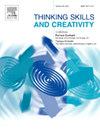Meaning making in an art context affects semantic distance: The case of semantic inconsistencies in written language
IF 3.7
2区 教育学
Q1 Social Sciences
引用次数: 0
Abstract
When people know they are encountering art, that awareness may change how they interpret what they experience. However, it is not clear how engaging with art affects cognition in everyday life. This collection of studies investigates how meaning-making in an art context influences semantic distance. Semantic distance involves connecting weakly-related concepts and plays an important role in cognitive processes such as memory and creativity. Across four studies, participants attributed meaning to semantically incongruent sentences («Most cats see well at court”), believing either that they were or were not created by artists. We then measured the effects on semantic distance using a network-based approach (Studies 1 and 2) and a sensorimotor distance-based approach (Studies 3 and 4). In Studies 1 and 2, participants decided whether two words were related or unrelated in word pairs with varying path lengths (e.g., ashtray-smoking, sea-survey). In Studies 3 and 4, participants made similar decisions for word pairs that were either closely associated ('to see' – 'colour') or distantly associated ('to see' – 'song') with different sensory modalities. In Studies 1 and 3, both prime and target words were presented without time limitations, and participants in the art condition evaluated distant word pairs as more strongly associated compared to those in the baseline condition. In Studies 2 and 4, participants performed similar tasks, but prime and target words appeared only briefly, reducing the influence of top-down deliberation processes and decreasing the observed effects. These findings suggest that meaning-making in an art context facilitates connecting distant concepts, offering insights into how art impacts cognition in everyday life.
求助全文
约1分钟内获得全文
求助全文
来源期刊

Thinking Skills and Creativity
EDUCATION & EDUCATIONAL RESEARCH-
CiteScore
6.40
自引率
16.20%
发文量
172
审稿时长
76 days
期刊介绍:
Thinking Skills and Creativity is a new journal providing a peer-reviewed forum for communication and debate for the community of researchers interested in teaching for thinking and creativity. Papers may represent a variety of theoretical perspectives and methodological approaches and may relate to any age level in a diversity of settings: formal and informal, education and work-based.
 求助内容:
求助内容: 应助结果提醒方式:
应助结果提醒方式:


